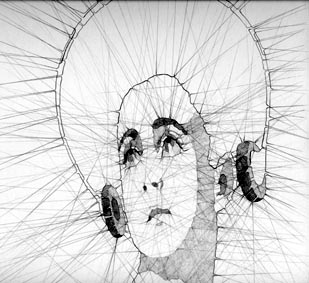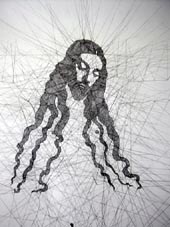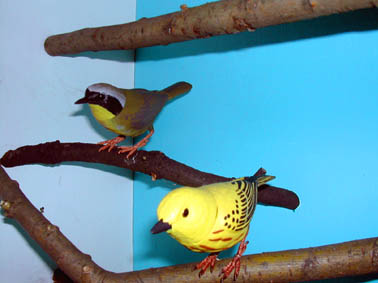It is possible that something similar to what Christianity did to the Roman Empire is needed in the present situation of a liberal-capitalist world order; or more precisely, as an early formulation of unconditional ethical engagement it might be exemplary in any active response to the vacuous freedoms of the liberal ‘multiculturalist’ compromise. An exhibition that deals with Christian iconography is not, then, as anachronistic as it might first appear.
 |
| George Bolster: Addicted to Heavenly Music, 2005; pencil on paper: courtesy Pallas Heights |
Downstairs at Pallas, an elongated, coffin-shaped projection screen shows Post life pre life (the washing the body) in which a naked Bolster sinks slowly down through a flotation tank to the regretful melodies of Johnny Cash. Bolster’s final resting position replicates that of Christ in Holbein’s The deposition of Christ in the tomb. The gravitas of Holbein’s panel is matched by the gravity causing Bolster’s descent, just as Holbein’s cool palette is repeated across Bolster’s pallid skin.
The introduction of (almost) contemporary music into a scene traditionally demanding of solemnity is a move reminiscent of the playwright Bertolt Brecht, most often made to disrupt conventional empathetic relations between performers and audience, and to introduce ‘foreign’ elements that cannot be smoothly absorbed into the work. Here, however, the music is not disruptive but largely supportive of the work’s consistency, despite Cash’s naturally sardonic tones. Likewise, the analogy Bolster draws between the figure of Christ and that of the artist himself is a little shop-worn. Are we being asked once again to consider the decline of the Saviour, Hero, Revolutionary, etc., and the laying to rest of the Artist as their latter-day proxy?
Painted four years after Luther nailed his ‘Ninety-Five Theses’ to the door of Wittenberg church, Holbein’s ‘Dead Christ’ is, perhaps, an assertion of faith in the representative power of painting faced with the increasing iconoclasm of the Reformation. It is, more than anything, a minutely-observed depiction of a corpse in a state of rigor mortis, putrefaction and muscle collapse; something like a post-mortem examination. Bolster’s contemporary examination seems rather weak in comparison, uncertain of both its subject and its method.
Holbein’s painting is also about faith in a broader sense. He is not renowned for having been a pious man: and by opting to depict ‘the time between Good Friday and Easter Sunday when Christ was neither man nor deity, the time when he was dead’ (Michael Prodger), he sets up a challenge to faith, suggesting that, faced with such harrowing visual evidence, only faith that is blind could bring this corpse back to life. But despite, or because of, the lack of even the slightest spiritual nuance, it could be that Holbein leaves us with as adequate a depiction as possible of the ‘word made flesh’, most literally, in an environment where the Word was paramount: the word made so fully flesh, in fact, that only the supreme act of faith – a miracle – could resurrect it. In this respect, it seems to correspond with the Reformation slogan, ‘Justification by faith alone’; that is, through being ‘reborn in faith’ to live in imitatio Christi, and, so the story goes, to partake of the possibility of redemption and Divine Grace. Most importantly for those who do not seek Divine Grace, there might be a similarity between a miraculous event and an act of freedom, in that both are uncontrollable and unpredictable: for Hannah Arendt, freedom was “to begin something new and … not [be] able to control or even foretell its consequences."
There is then, not least, a correspondence between an act of faith and an act of freedom; and both stand against, and cannot be accounted for within the administrated freedoms that are currently available to us. Perhaps when we are told that ‘nothing really happens’, i.e. the freedom of an event that would disturb the normal run of things is delusory, then the response that would carry most weight would be to assert that, indeed, miracles do happen .
 |
| George Bolster: Stigmata, 2005; pencil on paper; courtesy Pallas Heights |
Whatever one might think of the Christian faith, it remains a complex subject which cannot be wholly reduced to the ‘dead letters’ of its Law and its visual iconography, but these complexities are somewhat brushed aside by Bolster’s recourse to a familiarly ironic position. As has been noted elsewhere, irony is more conformist and less iconoclastic than it thinks it is; perhaps the most disturbing position would be excessive identification with one’s subject. It is in this way that Holbein combines both iconoclasm and its alternative, through rendering Christ as just another human being, and hence, through identification with the material fact of Christ’s death and the human endeavour that is required to resurrect it. We might even say that Holbein’s is a gesture which aims at repeating the conditions of Christ’s death, not simply re-enacting them, or worse, ‘structurally adjusting’ them to present conditions. If one is to repeat this situation, one must be prepared to fully accept the, often brutal, consequences of this decision. Bolster’s use of a flotation tank suggests the laying down of his body as a return to some self-contained, womb-like environment – some return, perhaps, to the body of Christ; but the power of Holbein’s painting is that its subject is allowed no such reconciliation.
Upstairs, three small drawings play with some ambiguities of iconic representation. In Madonna of rock (2005) the halo that signals her divine status doubles as an enormous set of headphones, whilst her hands that seem to hold an absent Child could also be playing slap bass: unsurprisingly, Madonna could also be a musician, or a rock star. Addicted to heavenly music (2005) shows the Madonna turning her flooded, ‘El Greco’ eyes heavenward. Again, her halo allows her to listen to divine music, interior voices, and ultimately, to make communion with God. Madonna becomes a groupie, a fan of God, isolating herself from this world and contacting another, presumably more esoteric realm. The manner in which they are drawn – from interlocking pencil lines of varying density which spread out in many directions like needles – gives these drawings a look of radiance and ephemerality which here corresponds to their subject; but elsewhere this correspondence becomes forced and rather gimmicky. For instance, a pair of drawings shows the Christ Child from front and back: at front, red threads pour from his stigmata; at back, a Gothic tattoo marks the child as ‘JEWISH’. The drawing’s title is Asylum seeker, and hence the persecution of Jesus is aligned with that of present-day refugees. But the shift in this series of drawings from cheap irony to politics belittles the latter and makes the former trite.
This triteness is displayed clearly in Stigmata (2005); an “installation of two wall-sized drawings of the crucified Christ and St Theresa of Avila who appears to receive the stigmata [from] the figure of Christ in the form [of] of red threads that span the room." The two drawings are placed opposite one another, showing St Theresa and Christ in the self-contained bind of ecstatic union. But there is little play or development in this construction, and it serves only to illustrate the very simple fact of this union. For example, the most obvious precursor to Bolster’s Stigmata is Bernini’s famous baroque sculpture, Ecstasy of St Theresa; but in Bolster’s variation even the sexual undercurrents of St Theresa’s rapture so evident in Bernini’s sculpture are lacking. The union, as it is represented by Bolster, is without nuance or movement, and ultimately falls flat.
 |
| George Bolster, Being St Franci s, 2005; mixed media installation; courtesy Pallas Heights |
The most incongruous piece in the exhibition is a cumbersome wooden box fixed to the wall just below head height in the corner of one of the rooms upstairs. There is an opening on the bottom side into which the curious visitor places their head. Doing this one is greeted by an array of twittering plastic birds not more than a couple of inches away. The title of the piece is Being St Francis, and indeed it would require the presence of mind of a saint to remain for long in such an intimidating, claustrophobic space. The main innovation of this piece is not, however, in how it ‘examines’ contemporary variations of sainthood or discipleship, unconditional subjective engagement, communion with nature, or any other such subject: it is, rather, the physical shock of being in such a situation without warning. But this shock soon dulls, the drollery is soon exhausted, and as such, lacks the sustenance required for any but the most cursory of examinations.
Tim Stott is a critic based in Dublin.